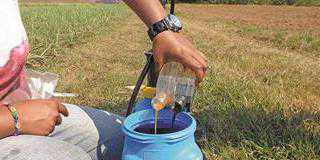
Photo: FW Archive
Most processes in agriculture use chemical intervention either to boost plant or animal production, or to prevent or treat diseases. Whilst such chemicals may be necessary to achieve desirable farming results and thereby help ensure food security, they can contribute to contamination of the environment.
Contaminants of emerging concern (CECs) have recently been highlighted as a priority problem in South Africa’s freshwater ecosystems.
What are agricultural contaminants?
CECs are best described as unregulated, synthetic or naturally occurring chemicals, particles or micro-organisms commonly found in surface water resources, as well as the environment in trace amounts.
They are not typically detectable or monitored. Agricultural CECs are contaminants that originate from agricultural inputs such as inorganic fertilisers, pesticides, herbicides, fungicides and hormones. These inputs are increasingly used in agriculture to increase livestock production, crop quality and yield.
Soil health decline and infringement on farming lands have put strain on the availability of food resources to sustain the world’s growing population. Population growth is fuelling the increasing demand for food and water due to the number of people exceeding resource availability. This has put pressure on the agriculture sector to use a number of inputs to improve yield and output.
The various agricultural industries are therefore compelled to use synthetic products to accommodate their respective customers. For example, livestock farmers have adopted the use of veterinary medicines such as hormones to increase animal and dairy output, while there is also an increase in the use of chemicals and other inorganic substances in crop farming.
These inputs are used to fight pests, weeds and micro-organisms that pose a threat to crop quality and yield by feeding on the plants, thereby either damaging them or stunting their growth.
Entry into water sources
Agricultural CECs enter water sources in different ways, depending on the nature of the CEC and its method of application. Some CECs, being in either liquid or powder form, are applied through spraying.
During this process, they are blown by the wind into the atmosphere and can land in open water sources such as rivers, dams and lakes that may be used by surrounding communities.
However, the most common route of agricultural CECs into water sources is through run-off. During the rainy season, the CECs that settle on the crop and soil are easily washed off by precipitation and deposited into nearby water bodies.
Commonly used hormones such as oestrogen and androgen can enter the environment due to improper disposal after use, but are most commonly excreted by animals, which use only a portion of the hormones or medicine. As they are not biodegradeable, these residues tend to accumulate in the aquatic environment, where they pose a threat to aquatic life.
Impact on water-dependent organisms
Increasing quantities of agricultural CECs in water bodies reduce water quality and directly affect all organisms that depend on those water resources.
Studies have shown that various pesticides, fungicides and veterinary medicine residues can induce endocrine-disrupting activity, promote carcinogenesis in humans, and trigger physical as well as reproductive behavioural changes in aquatic animals.
They are also thought to have a negative genetic and reproductive impact on crucial environmental micro-organisms in water and soil by altering fundamental environmental factors such as pH, moisture content and oxygen concentration.
Changes in environmental conditions have a direct effect on organisms, and may lead to fatalities of aquatic animals, including fish and frogs. These changes may be small, but they have a significant impact on the food chain and ecology as a whole by causing an imbalance in the ecosystem.
Management and mitigation
The use of inorganic agricultural inputs can be reduced by practising organic farming methods such as the use of organic and biodegradable farming amendments. There is a growing interest in the organic approach, which is driven by the introduction of more environmentally friendly alternatives.
However, even these organic substances can cause contamination if used excessively. Simple changes such as using appropriate quantities of organic biofertilisers as well as eco-friendly substances with lower levels of chemicals can significantly reduce the footprint of agricultural CECs, although they are more costly than their traditional counterparts.
Contaminants can also wash downstream from sources where release occurs upstream.
Knowledge Hub
The Agricultural Research Council, in collaboration with Tshwane University of Technology, North-West University and the University of South Africa, initiated a project funded by the Water Research Commission to establish the CEC Knowledge Hub. This takes the form of an online portal consisting of information relating to newly detected aquatic pollutants.
Farmers are asked to submit any questions they may have on water quality or on CECs
they suspect could be present on their farms to the CEC Knowledge Hub. This information will then be used to set up an information page on the project website in order to help farmers mitigate the risk of exposure to CECs and educate them on how to monitor their water quality in the long term.
Email Dr Tarryn Lee Botha at [email protected], Fanelesibonge Vilakazi
at [email protected], or Dr Ashira Roopnarain at [email protected].











